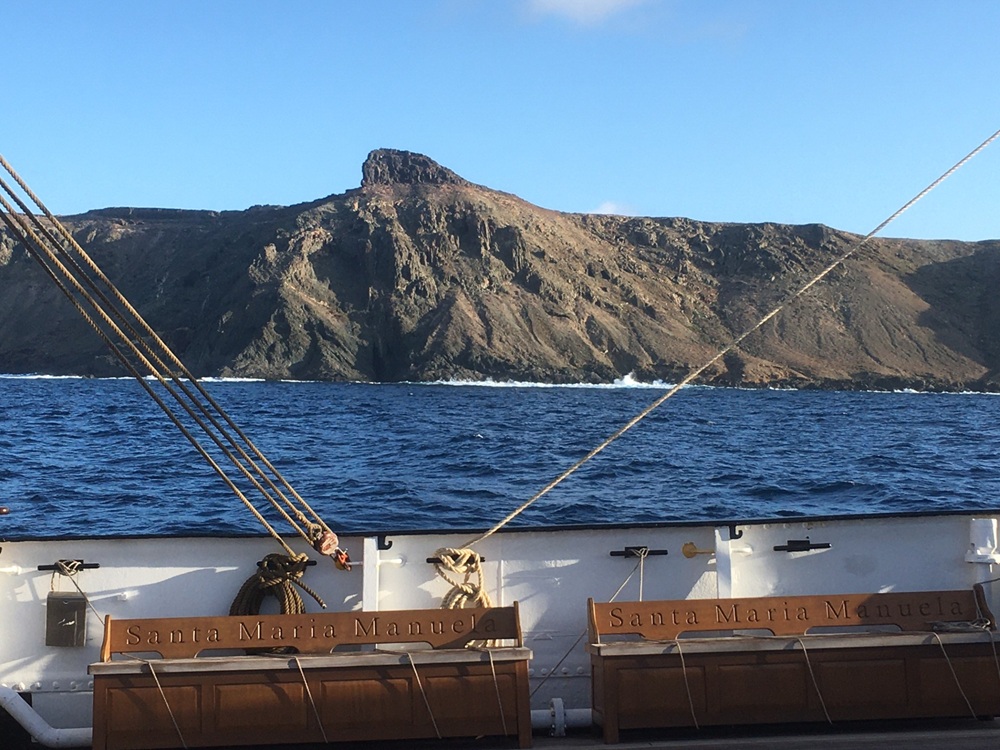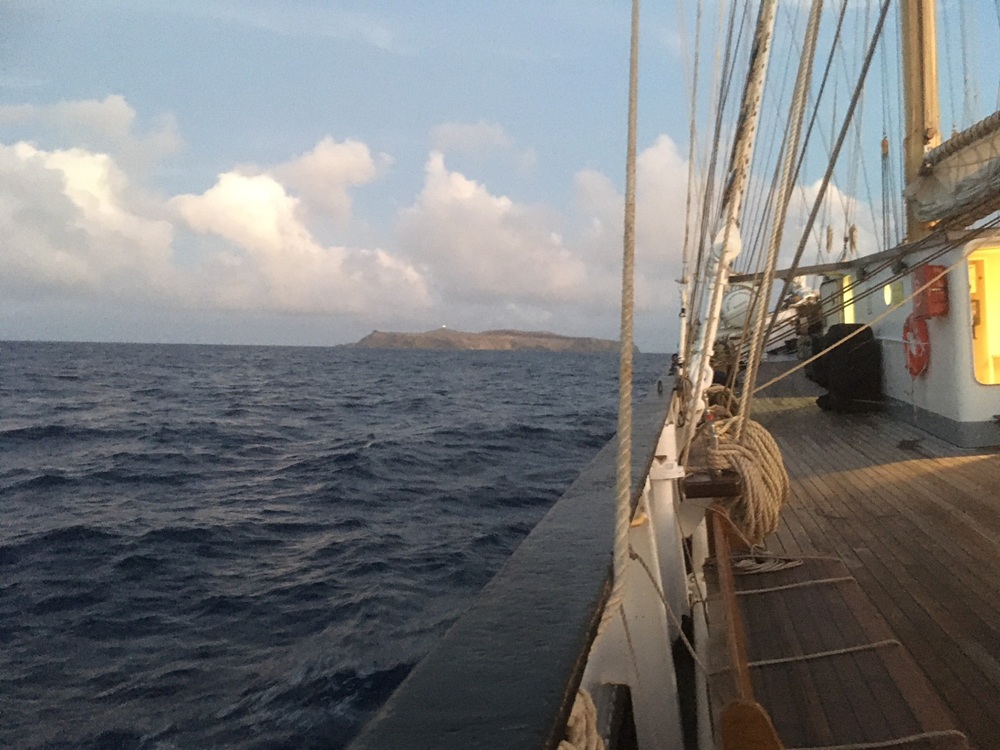Letter from a Savage Island

Anthony Burgess
I did not take much persuading when my son Daniel asked me to join him on an Atlantic sailing adventure to sail to the islands known as the Savage, Salvage, or Selvagen Islands.
These Macaronesia Islands are about one hundred and eighty nautical miles from Madeira and are Proudly Portuguese territory. This Portuguese archipelago comprises of Selvegen Grande and Selvegen Pequera and are Portugal’s most southernmost point.
I must hastily add that I had never heard of them before but after some research I discovered the importance of these islands as nature and marine reserves hugely important as nesting sites and resting sites for many threatened migratory bird species also they are home to many rare species of flora.

We joined the beautifully restored four masted schooner ‘Santa Maria Manuele’ in Tenerife to begin our journey to these relatively inaccessible Islands. This lateen and square-rigged sailing vessel is truly stunning to behold. It oozes elegance, serenity, and character that reflects the time it was built the 1930’s.
It was built in Lisburn in an incredible record time of 62 days ironically when it was fully restored in 2007 the operation took four years!
Its elegance conceals the fact that it was built as a cod fishing vessel that would transport 45 fishermen and their small rowing Dory’s as far as Newfoundland. Here they would be lowered into the waters with one fisherman per boat and from this small platform they would fish for cod. Each fisherman in their Dory was expected to catch at least 500kg of cod.
Back on board it was gutted and salted. The fishermen were only paid for what they landed, and their only means of finding the Santa Maria after drifting miles was by the constant ringing of a bell aboard her.
These fishing trips would take approx. six months.
Did someone say these were the good old days? We would definitely experience more comfort that those poor souls experienced.
As we joined the boat our thoughts and mind were full of anxiety and trepidation as what to expect during the next few days blue sea sailing. The captain and his crew soon put our minds to rest though with their warmth of greeting that conveyed a reassuring and very professional skill set by them all.
However, the weather decided that it would not be as friendly, just after boarding a capricious wind swept in and within the hour the whole of Tenerife was put into a storm warning lockdown for fear of damage to property and life.
I understand a storm force of 9/10 on the Beaufort scale was recorded. So, our departure was delayed until the next day when the strength of wind would drop.
Which it did and by nine the next day we cast off the mooring ropes and edged out of Santa Cruz harbour. I felt excitement and anticipation despite the captain forewarning us of 4-5 metre swell at sea.

Within an hour out from Tenerife sightings of two pilot whales and a pod of Atlantic bottle nose dolphins rose our spirits even higher as they cavorted along the whole length of the boat.
The surface of the toledo steel coloured heaving sea was strewn with wave crested ‘white horses’ racing in all directions, some slapping forcibly onto the hull of the boat to shoot a fine rainbow of spray over all and sundry.
For such a large sailing vessel though it was extremely quiet, the strength of the invisible wind would sometimes take you aback as it brushed past you, soon many wind burned cheeks and foreheads appeared on the faces of everyone on deck.
I must admit at this point I experienced some ‘Mal de Mer’ symptoms and quietly and diplomatically retreated to my bunk where I stayed for twenty-four hours until I was confident that my sea legs had at long last joined me on this voyage…
The sky the next morning was a welcoming fresh mackerel blue, it somewhat compensated for me missing yesterday’s sighting of Orcas as I lay in my bunk preserving my dignity. The sun’s rays created a shimmering pathway on the sea which stretched to the horizon where the imposing dark outline of the largest Savage Island rose up out of the Atlantic. Soon we saw some Cory’s Shearwaters following us, perhaps mistaking us for a fishing vessel.

These few Shearwaters quickly grew into a vast flock. They entertained us with their acrobatic skills flying just centimetres over the surface of the sea. Unfortunately, the aftermath of the previous storm had sadly loitered here as the seas swell reflected.
As we approached this ‘Savage Island’ I fully understood how appropriate its name is. It is an extremely dangerous environment for boats and sailors. The captain had radioed the wardens on the island to ascertain whether they deemed it safe for the rubber rib to be used to transport us ashore, they left the decision to his much greater sea knowledge.
He did send three crew members in it for them to report upon conditions and whether it was safe and suitable to land, but just watching the rib bouncing over the waves I think I knew the answer before they returned. It was deemed too dangerous for the rib to carry us ashore.
The disappointment amongst us was palpable but after witnessing the power and indiscriminate anger of the Atlantic Ocean at first hand I knew it was the right decision.
We sailed around the Island and had a taster of what birdlife was ashore, as we saw terns, an osprey and incredibly a marsh harrier and of course more of the thousands of the Cory’s shearwaters that nest here.
A cave into the cliff face was pointed out as being used by the pirate Captains Kidd to stash treasure. If it’s true, hats off to the man for his sailing prowess.
The Islands unique flora and fauna was something I had particularly liked to witness at first hand but was not to be on this trip. This Island has a small Portuguese Naval presence, several service people are continually monitoring the marine reserve for any illegal fishing activity.
After we had witnessed the birdlife around the Island the Captain slowly turned The Santa Maria Manuela towards the smaller savage island several miles away. It was not long before we spotted our fist white faced Storm Petrel, this smaller of the savage islands is home to 60,000 of them.
Hugely dangerous sandbanks encircle the Island, fatal for boats but an absolute 24/7 food source for these Petrels. They are colloquially called Calca-mar or sea jumpers we witnessed them hover just above the sea hunting before they literally step on the surface and fly off.. Access to the environs of this Island is strictly prohibited, so we kept a very respectable distance before our final journey to Madeira.
The sea became calmer on this leg, its violent slapping along the hull changed to a gentle murmuring. The Dolphins returned to amuse and enthral us as did a solitary Pilot whale. Some shearwaters followed again. Chairs were placed on the deck and food was eaten on previously unused stashed tables.
An occasional rogue wave ‘refreshed ‘us all as it broke over the port side but the sea was a much kinder beast than we had previously experienced. The pink delicate, gossamer like sails of Portuguese men of war gracefully and innocently glided by, it was hard to imagine their lethal prowess below the waves.

The next morning on our very last leg we sailed past the Deserted Islands another reserve not far from Madeira, which is home to an exceptional rare seal, the Monk seal. Only 30-40 of these are recoded here. They are the world rarest seal species. I sincerely hope they recover. After witnessing the very impressive environmental protections put in place by The Portuguese Government, I am reassured of this.
Unfortunately, the voyage ended the next day, this beautiful schooner, The Santa Maria Manuela had been our home for the past week. A bond had developed between the boat, the crew and ourselves so it was a sad parting.
As I looked around Funchal harbour our schooner was dwarfed by the several moored cruise liners, despite the on board comforts these vessels advertise I would never have swapped my bunk, the rolling deck, the occasional shower from spray or the wind burn experienced on The Santa Maria Manuela for any of the ‘delights’ promoted by these.
I felt as one with nature and conscious free sailing in her, all was well in the world.
Support our Nation today
For the price of a cup of coffee a month you can help us create an independent, not-for-profit, national news service for the people of Wales, by the people of Wales.





Interesting article, I think I’ll book a trip!